#valtionrautatiet
Explore tagged Tumblr posts
Text
oon nyt ollu kahdessa VR junassa missä siivoojat on ollu pitkiä ja gnc as fuck. meikä mänletti ei meinaa pystyy ajatteleen kun ne tulee kyselee et onks roskia ku haluun et ne noukkii mut ku tyhjän vichy pullon lattialta
7 notes
·
View notes
Text
Railway ask game!
Favourite railway station?
Weird thing that happened to you on a train/on a train station?
Do you feel like railway and the tracks belong to the landscape or do you feel like they invade it, they are unnatural?
Do you have a favourite song about trains/which features trains? (If not, please listen to Plenty good room here)
Favourite railway company (other than Správa železnic. We know everybody loves us ofc)
Do you have a favourite locomotive/train type? If not, pick one and share a picture.
The most beautiful route you have taken so far (by train ofc)
Have you ever met friends with anyone on a train?
Delays, unexpected events and so on: complaining time! Tell us.
Your favourite train in fiction, if you have one. If you don't, do you remember any train from a book or a movie?
@zssk @ceske-drahy @regiojet @arriva-cr @mavcsoport @valtionrautatiet-official @flixbus-official @nederlandsespoorwegen @british-rail-official @british-rail @deutsche-bahn @zeleznice-slovenskej-republiky and other 🚂
179 notes
·
View notes
Text
GUYS! 🚆🚂🚞
I've seen this bingo on twitter and I think there is definitely a group here that needs to play it too!

@ceske-drahy @regiojet @arriva-cr @mavcsoport @valtionrautatiet-official @flixbus-official @nederlandsespoorwegen @british-rail-official @british-rail @deutsche-bahn @zeleznice-slovenskej-republiky @zssk and other 🚂
34 notes
·
View notes
Text


Osaako meidän @valtionrautatiet-official sanoa, onko Suomessa muita yhtä merenläheisiä junaseisakkeita kuin Uudenkaupungin Kalaranta?
Kuinka ihanan romanttinen ajatus onkaan, että ensin tulla säksättää saaristosta puupaatilla kaupunkiin, hyppää paatista junaan ja puksuttaa sillä suureen Turkuun, mahdollisesti jatkaen vieläkin suurempaan Helsinkiin!
Haluan elää maailmassa, jossa yksityisautoilu ei ole niin ylivoimaisen dominoiva kulkumuoto mitä se nyt on, vaan olis ihan tavallista liikkua arkiasioissa paatillakin.
29 notes
·
View notes
Text

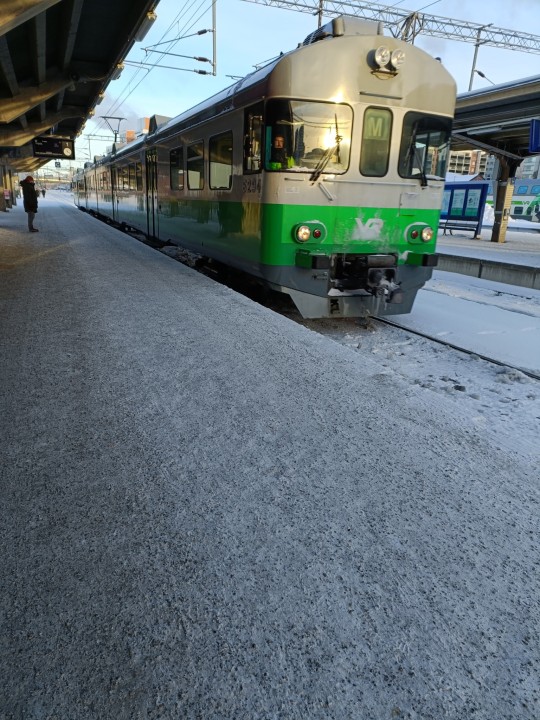
Sm2 -lähijuna Tampereella
Oma kuva, 15.1.2024
@valtionrautatiet-official
21 notes
·
View notes
Text

The Class E11 was the first electric locomotive class built in the GDR, with production starting in 1961. Pictured here is 211 001-3 in the Deutsche Bahn Museum in Nuremberg.
The factory where it was built carried the name of Hans Beimler, who among other things served as a political officer in the famous Thälmann-Batallion for the International Brigades in the spanish civil war, where he was killed in action. In his earlier life he was working in a locomotive factory in Nuremberg, where he was part of the works council. His Grandson (also called Hans Beimler) lives in the USA and most notably wrote for Star Trek TNG.
@valtionrautatiet-official
@punalippulaiva
@femboytrain
#E11#public transit#deutsche bahn#deutsche reichsbahn#Hans Beimler#nürnberg#nuremberg#Thälmann#wählt thälmann#ernst thälmann#locomotive#trains#analog photography#ФЭД2#FED 2#feliks appreciation post#washi D#500 ISO#star trek#TNG
21 notes
·
View notes
Text
GE PowerHaul
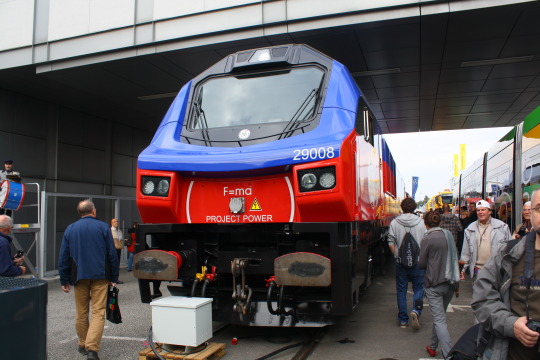
After I offered, @valtionrautatiet-official asked me to post some pictures of the locomotive that is nowadays known as the Dr20, used by the private freight operator North Rail in Finland. Here it is in 2012, long before anyone ever even considered sending it to Finland, in Berlin. The reason that it's in Berlin specifically is that it's at Innotrans, the biggest trade fair and exhibition for railroads that exists. At this point it had the paint job of HHPI (Heavy Haul Power International, despite the important sounding name really just one of many European freight rail companies with headquarters in Germany), with their trademark blue and red and their company policy of putting Newton's second law on it. "Project Power" also sounds cool, doesn't it? Well, it turns out they never entered service for HHPI. Way too much history under the cut.
The story behind these eight locomotives is weird and opaque, and there is a lot of stuff we may never know, but on a very fundamental level it seems to be one of the victims of what I call the six-axle diesel curse. This basic of that theory of mine is that it's impossible to sell big, heavy, powerful diesel locomotives, the kind that are so powerful that they need six axles for all the weight from their big engine and diesel tank, in (West) Germany and to a certain extent central and Western Europe, at least nowadays, unless you do it by accident.
The German locomotive industry has wanted to build big six-axle diesel locomotives since the end of steam traction. There was a prototype six-axle version of the V 200, named V 300, in the 1950s, but DB didn't want it (a related but less powerful version was sold to Yugoslavia to haul Tito's private train). For the Americans here, the Krauss-Maffei locomotives of the Southern Pacific and Rio Grande were related to that.
A few years later, in 1962, we get the V 320, a six-axle version of the V 160 locomotive family. The four-axle version was very popular and is still in service, but they only built the prototype of the six-axle version. Interestingly, that one prototype is still around as well, hauling construction trains. Deutsche Bahn was never interested, they preferred the flexibility of having more smaller units. And anyway, they were busy electrifying the busy main lines that would have made the most use of those heavy machines.
In the 1970s Henschel and BBC (the electric equipment one, not the British TV one) built three copies of the DE 2500 both with four and six axles, but those were really more experimental machines.
In the late 1980s and early 1990s, MaK tried to sell their DE 1024, and I actually have a picture of that ne.
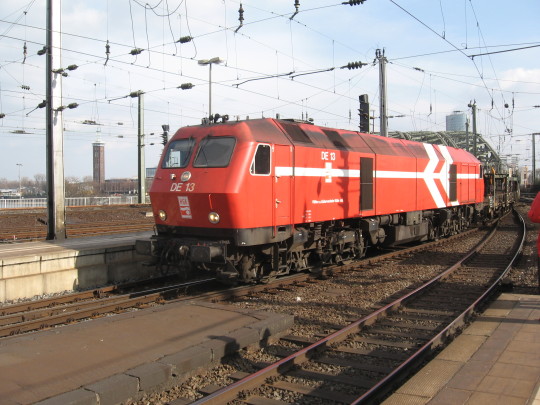
They built three prototypes, and Deutsche Bahn seemed to genuinely toy with the idea… but in the end it was decided to electrify the lines in the (mostly flat) north that hadn't been electrified yet anyway.
And at the same time, the wall fell, and suddenly Germany had access to all the locomotives of the east, now mostly surplus since mostly the industry they served did not survive the transition to western markets. East Germany had bought powerful six-axle diesel locomotives in enormous numbers from the Soviet Union, specifically modern-day Ukraine, and those were available, good enough and already paid for. In particular the class 232 and related, known as "Ludmilla" among rail fans, have proven very useful.
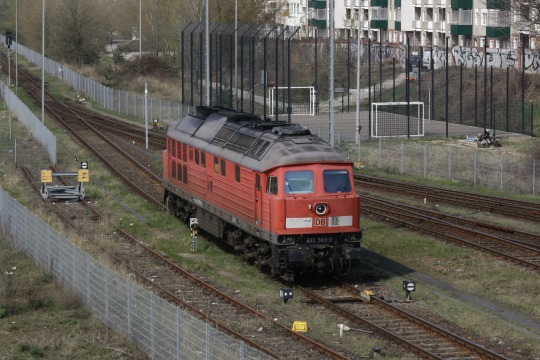
MaK was able to sell an altered version of that locomotive to Norway, but that turned out to be be a huge disaster as they developed a habit of catching on fire. Eventually Siemens (who briefly owned MaK) had to take them back, and since then they've changed hands an astonishing number of times - apparently right now Hector Rail and RDC Autozug have a lot of them. Here's one in Hamburg Altona when it was used on regional trains there.

The three prototypes went to locally owned operator HGK, where two of them also burned down. DB probably dodged a bullet there. Interestingly enough, the only one that didn't burn down was number 13, but that was finally scrapped a few years ago.
In the mid-1990s, ADtranz (later Bombardier) and GE got together to build the Blue Tiger locomotive, a very distinctive-looking and noisy machine. They sold 11 to various private operators in Germany, 30 to Pakistan and 20 to Malaysia. Not terrible, but not a huge success either.
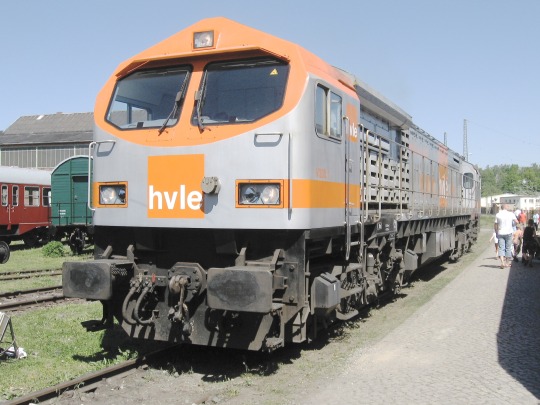
But in the 2000s, things were changing. Liberalisation meant that more and more companies were running services all throughout Europe. The busy main lines were electrified, but many of the border crossings weren't yet, so there was a new need for big six-axle diesel locomotives.
The big beneficiary of this was EMD from North America, who were already supplying such locomotives to Great Britain. The rail companies there needed these machines to replace unreliable British-built power, and to replace environmentally friendly electric locomotives, because most of the British network is not electrified and the few sections that are have way too much traffic on them.
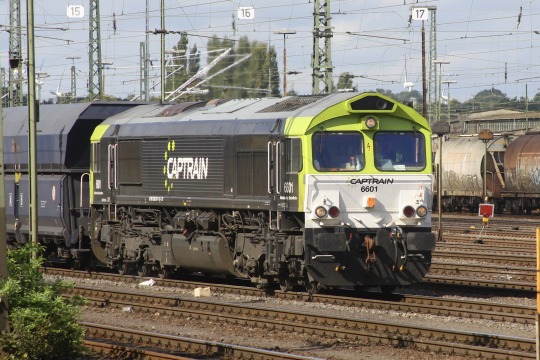
The Class 66 is an ugly mess, designed by figuratively building a metal shed in the inside of a tiny British rail tunnel. It's so noisy that drivers in Norway get hazard pay for being in them. But it works and it was mass produced, and a lot of them made their way to the continent in short order.
Other companies wanted in on that business. Voith decided to enter locomotive building after previously supplying traction equipment. They had high hopes for their Maxima series of locomotives, which they started building in 2008, and they had their own leasing company. They did a lot of marketing and the machine won prestigious design awards.

At one point they had a hundred pre-orders. In the end their own leasing company folded, and they only built twenty, which they didn't even manage to sell that quickly. Nowadays they've stopped producing locomotives again.
General Electric, the other North American locomotive company, wanted in on that action as well. Sure, it hadn't worked with the Blue Tiger, but years had passed and things were different now. For their new product, the PowerHaul, they decided to follow what EMD had done. They started with the class 77 for the British market, first shown at Innotrans in 2010.
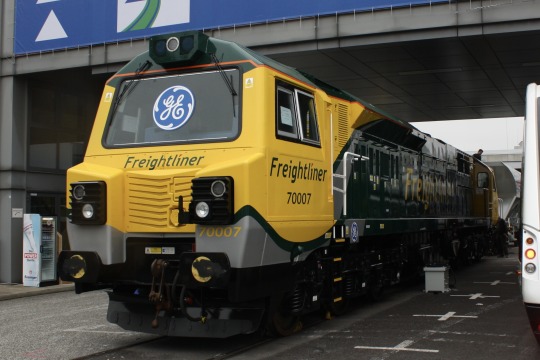
Then they wanted to work their way out to wider Europe, with a special continental version that was designed with a bigger shell to match the larger tunnels on the continent. That way they weren't quite as cramped. EMD had considered a similar idea, a European-sized class 66, but decided against that.
GE also did not intend to make them themselves. Instead after the initial batch of British 77s, they transferred production to their Turkish partner Tülomsaş, who supplied some more British ones and the ones for central Europe. 29008 is one of them.
In the end all of these plans fell through. A lot of the international border crossings did get electrified much quicker than the diesel sellers had hoped. The one near where I live, the Montzenroute, started electric running in December of 2008, and it was actually the makers of electric locomotives who made bank off of the new international railway world. Here is a Bombardier TRAXX electric locomotive during the first week that freight trains from Germany to Belgium were running with electric power, just a few hundred meters from the border.
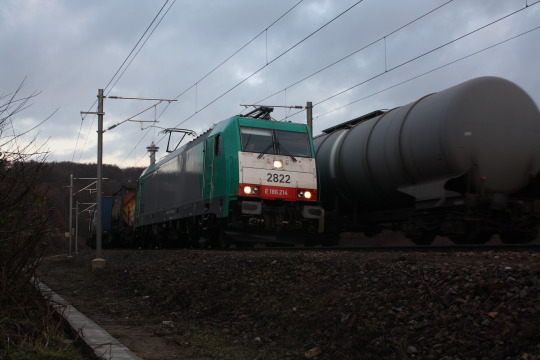
But the business changing is one thing, the story of the PowerHauls seems to be even more complicated. After all, GE did have a launch customer for their PowerHaul, in the form of HHPI. The locomotives were built, painted in HHPI colors, and tested. And then… well, nothing. They never entered service, instead sitting for years in Cottbus, Germany. I have no idea whether they ever got approved for service in Germany. Finnish Wikipedia says "HHPI had no use for them", but that sounds like a euphemism. Clearly HHPI had some use for powerful locomotives, they've recently taken delivery of some Stadler EuroDuals.
The EuroDual and the closely related Euro9000, pictured below, seem to be the solution to the six axle diesel curse though the conceptually simple but technologically difficult trick of simultaneously being a very powerful electric locomotive as well. They have already delivered more of them than Voith Maxima, GE Blue Tiger and GE PowerHaul combined. Sorry for the pictures, they don't park the locomotives well for good photos at Innotrans.
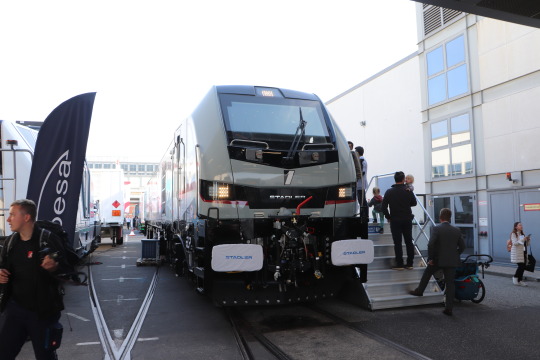
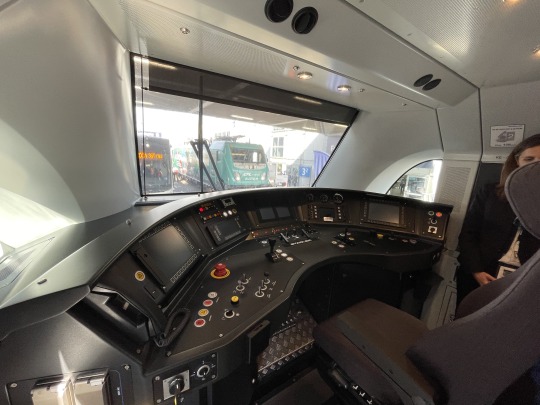
Also, GE was not able to find any customer in Germany, nor in Sweden, where some units of that type were tested at some point. Locomotives of that type were built for Turkey, though, and I haven't heard anything negative about them there. Those were also at Innotrans, in 2014.
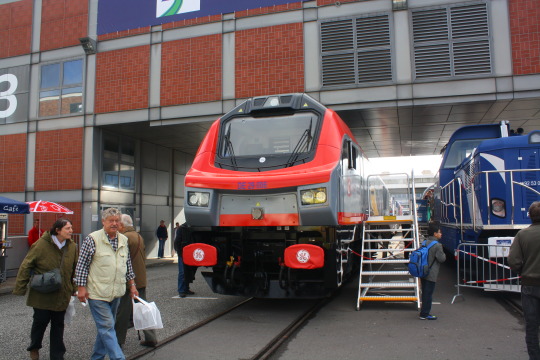
And then, years after everyone had forgotten about these machines, they suddenly turned up in Finland, in the hands of North Rail (formerly Operail), one of the few private companies there. That required at least new couplings, new axles (Finland has a different rail gauge, the measurement of how far the rails are apart), probably adjustments to the breaks, new train control systems and so on.
It's possible that North Rail was thoroughly convinced by the advantages of GE's concept or something, but I think it's far more likely that they just got a really good deal because GE was happy someone took them off their hands.
The reason they're in Finland is almost certainly that Operail needed some cheap machines that weren't doing anything, and these units were just that. But why were they not doing anything? Why were these machines doomed to sit in Cottbus for years, essentially still in new condition, painted for an operator that didn't want them? I'm sure you'll find plenty of theories if you look on online forums, and it's even possible that one of them is the truth, but unless some rail journalist decides to really dig into that, we'll probably never know for certain.
If you allow me to speculate: It certainly doesn't sound like a success story, and there have been all sorts of other stories where trains didn't get approval to run in the country they were ordered for, or had severe technical defects. Ask an Austrian rail fan about the Talent 3, a danish about the IC 4 or a dutch or Belgian about the Fyra to get some really fun rants. I don't know if these locomotives belong in that hall of shame, but it would certainly be an explanation.
My guess is that there won't be any more of these machines ever. GE Transportation doesn't even exist anymore, the whole part of the business got sold to Wabtec a few years ago. But if these machines are doing well in Finland now, good for them! Finally someone found something to do with these weird-looking units.
16 notes
·
View notes
Text
Jee kirjoitin taas!
Tärkeimpänä, askartelin Menolippu-kartan Suomen rautateistä! Tämä oli keskeisin koko motivaatio tämän viimeistelyyn, halusin saattaa tämän @valtionrautatiet-official -saataville. Jutussa mukana tämä printattavana ja myös pisteytetyt menoliput, kaikki raiteille. (Vaatii Menolippu-pelin silti, mutta sitä löytyy hyvin kirjastoista!)

Kartta on siis odotellut yli vuoden että muodostaisin valistuneen mielipiteen henkilöraideliikenteen kilpailusta. Supertiiviisti: Hallitus aikoo avata markkinaa, avoin markkina on sinänsä ihan ok, mutta kilpailu itsessään huono juttu. -> Kannattaa vastustaa ainakin VR:ää heikentäviä muutoksia, vahva valtionyhtiö on paras tapa järjestää junaliikenne.
Sekavia metapohdintoja replyssä ->
5 notes
·
View notes
Text
Arvon @valtionrautatiet-official, tahtoisin tehdä valituksen!
Vaadin selitystä ja vähintäänkin tähtitieteellistä korvaussummaa henkilöstönne ajattelemattoman toiminnan vuoksi aiheutuneesta mielipahasta ja traumaattisen tapahtuman vuoksi herkkää mieltäni koetelleen heikotuksentunteen johdosta.
Antamassanne aikataulussa lupasitte tammikuun 19. päivänä Tampereelta kello 11.07 lähteneen junan IC93 saapuvan reitin pääteasemalle kello 12.40, mutta juna pysähtyikin laituriin jo kello 12.34! Ennenkuulumatonta. Kuusi kokonaista minuuttia etuajassa! Ennen junan asemalle saapumista konduktööri kuulutti, että kaikkien on poistuttava junasta viivyttelemättä, sillä yksikkö siirretään välittömästi sivuraiteille.
Ja minä sentään maksoin koko matka-ajasta ja nyt minulta jäi käyttämättä kuusi minuuttia! Vaadin mitä totisimmin käyttämättä jääneestä ajasta korvauksen, vain olisiko kenties mahdollista käyttää tämä kuusi minuuttia myöhemmin? Esimerkiksi junan joskus ehkäpä ollessa myöhässä aikataulustaan, voisin mieluusti käyttää nämä minuutit ja olla asemalla kuusi minuuttia ennen muita, jos se vain on mahollista.
Ystävällisin terveisin järkyttynyt junamatkustaja
29 notes
·
View notes
Text
Seuraavana: Cohost. Nästa: Cohost. The next stop: Cohost.
Kaikille VR-aiheista paska- ym. postausta kaipaaville tiedoksi annettakoon, että sama meno jatkuu nykyään Cohostissa. Eli jos haluat elämääsi uudelleen suomalaisen raidenörtin joka esittää VR:ää, kannattaa suunnata osoitteeseen https://cohost.org/valtionrautatiet-official
---
Järnvägs-skitposting fortsätter i Cohost, och falsk-statsjärvägarna kan hittas fortfarande i https://cohost.org/valtionrautatiet-official
---
Those who wished for a continuation of this blog can rejoice, for the fake account of the Finnish national rail operator has risen again and can be found at https://cohost.org/valtionrautatiet-official
---
(Niin ja kun ainakin @pupucino oli ihmetellyt tämän blogin kuolleistanousemista pääsiäisenä: en ollut tajunnut, että vaikka queuen laittaa tauolla niin Tumppu kuitenkin postaa queuen kanssa samassa listassa olevat ajastetut postaukset alkuperäisen aikataulun mukaan. Nyt queue on tyhjätty ja kaikki ajastetut postaukset poistettu, eli tähän blogiin ei tule enempää sisältöä).
23 notes
·
View notes
Photo
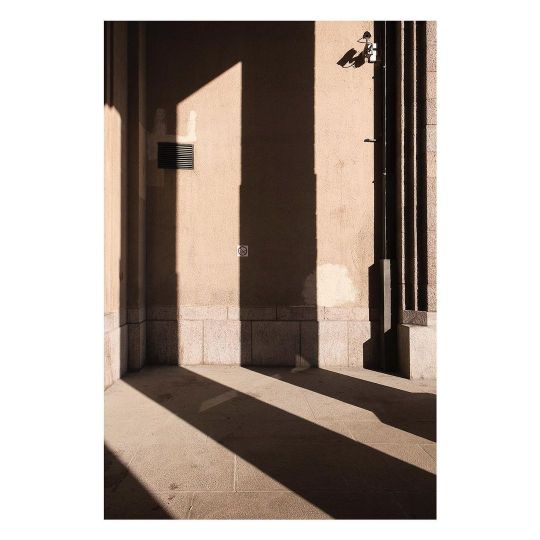
#helsingfors #helsinki #valtionrautatiet #visithelsinki #rautatieasema #grafic #exterior #photographyeveryday #photographylover #soulofstreet #architecturelovers #palepalmcollection #fromstreetswithlove #woofermagazine #earthescope #finearephotographer #conceptualphotography #simple #artisticphotography #emotive #visualcreators #visualsgang #architecture #shadow #reflection #great_captures_minimal #streetgallerymagazine #alteredlandscape (på/i Helsinki Rautatieasema) https://www.instagram.com/p/CfQuSdKoN4p/?igshid=NGJjMDIxMWI=
#helsingfors#helsinki#valtionrautatiet#visithelsinki#rautatieasema#grafic#exterior#photographyeveryday#photographylover#soulofstreet#architecturelovers#palepalmcollection#fromstreetswithlove#woofermagazine#earthescope#finearephotographer#conceptualphotography#simple#artisticphotography#emotive#visualcreators#visualsgang#architecture#shadow#reflection#great_captures_minimal#streetgallerymagazine#alteredlandscape
7 notes
·
View notes
Text
@valtionrautatiet-official
“Helsingin rautatieasema on illalla kuin Minecraft: pimeydestä alkaa spawnata hirviöitä”
— Poikakaveri
770 notes
·
View notes
Text

i LOVE getting a seat from the pet car
3 notes
·
View notes
Photo

#VR kulkee ja mun #päätepysäkki on #eteläpääty! Tänään kaatuu #lokomotiv #jaroslavl! #jokerit #helsinki #punakeltainen #valtionrautatiet #khl #kontinentalhockeyleague (paikassa KHL Jokerit)
#vr#päätepysäkki#helsinki#lokomotiv#valtionrautatiet#jokerit#punakeltainen#jaroslavl#khl#kontinentalhockeyleague#eteläpääty
0 notes
Text
Immersiivinen ostamisympäristö
Jos kysyisin kadulla vastaantulevilta ihmisiltä, että mikä ‘’VR’’ on, saisin varmasti vastaukseksi, että ‘’no Valtionrautatiet tottakai’’. Entä ‘’AR’’ sitten? Rakkaalla lapsella on monta nimeä, mutta nyt tosin ei puhuta junista, eikä rautateistä, vaan virtuaalisesta todellisuudesta ja sen mahdollisuuksista tulevaisuuden kaupankäynnissä.
VR, ja AR, eli ‘’virtual reality’’ ja ‘’augmented reality’’ (suom. ‘’virtuaalinen todellisuus’’ ja ‘’lisätty todellisuus’’) ovat teknologian kehityksen uusia tuulia, jotka kukin tavallaan muokkaavat todellisuutta erilaisten elektronisten laitteiden avulla. Nämä kolme on ehkä välillä hankala hahmottaa toisistaan, joten mitä eroa niillä sitten oikein on?
Virtuaalinen todellisuus, eli VR on kaikista lähimpänä sitä itseään, eli - no, virtuaalista todellisuutta. VR on kaikista kolmesta yleensä teknologisilta ominaisuuksiltaan kaikkein kallein toteuttaa, mutta se myös tuottaa realistisimman kokemuksen käyttäjälleen. Tietokoneteknologian avulla henkilö voi uppoutua täysin simuloituun ympäristöön, kuten videopelimaailmaan tai interaktiiviseen elokuvaan. Virtuaalisen todellisuuteen vaaditaan yleensä vähintään tietokone, VR-lasit ja jonkinlaiset ohjaimet, joiden avulla käyttäjä pystyy liikkumaan ja tutkimaan simuloitua ympäristöä.
AR, eli lisätty todellisuus on niin sanotusti paranneltu, tai tehostettu versio todellisuudesta, joka pystytään saavuttamaan esimerkiksi älypuhelimilla ja tableteilla, sekä niihin ladattavilla sovelluksilla, jotka toimivat puhelimen kameran avulla luoden kuvaruudulle keinotekoista informaatiota, kuten kuvia, tekstiä tai animaatioita. Tämänlaisia sovelluksia on esimerkiksi huippusuosittu peli PokémonGO, jota allekirjoittanutkin tuli pelanneeksi muutamia vuosia sitten. Pelissä käyttäjä seikkailee oikeassa maailmassa, johon sovellus luo pisteitä kartalle eri kohteisiin. Sovellus on reaaliaikainen ja toimii GPS-paikannuksen avulla, jolloin pelaaja pystyy vierailemaan pisteillä, missä pystyy taistelemaan muita oikeita ihmisiä vastaan ja keräämään uusia pokémoneja. Oli hauskaa tavata oikeassa elämässä muita pelaajia kännykät kädessä ja taistella elämästä ja kuolemsta sovelluksen sisällä. AR on siitä hyvä verrattuna virtuaalisen todellisuuteen, että se ei vaadi yhtä kallista teknologiaa käyttäjältään.
Voisiko näitä teknologian ihmeitä sitten muka käyttää jopa tulevaisuuden kaupankäynnissä? Ehdottomasti. Itse pidän tämänlaisia innovaatioita erittäin potentiaalisina ratkaisuin tulevaisuuden kuluttajalle ja yrityksille keinoina käydä kauppaa ja hoitamaan asioita kotoa käsin ympäristössä, joka on miellyttävää ja mahdollisesti myös hyvin räätälöity kuluttajan omiin mieltymyksiin. Tämä ei tule ehkä tapahtumaan ihan lähitulevaisuudessa, mutta olettaisin itse, että jo viimeistään kymmenen vuoden päästä meillä on mahdollisuus laittaa VR-lasit päähän, joka vie meidät simuloituun ruokakauppaan, jossa henkilö pystyy itse työntämään kärryjä ja valitsemaan ostoksensa kuin tosielämässä. Ostosten maksaminen niin ikään onnistuu kassalla ohjelmaan integroidun luottokortin, tai lisättävän saldon avulla, jonka jälkeen paikallinen ruokakauppa lähettää oikeassa elämässä ostokset suoraan kotiovelle! Yritysmaailmassa kokouksia ja kauppoja voidaan käydä simuloidun kokoushuoneen avulla, jossa henkilöt pystyvät keskustelemaan ja näkemään toisensa reaaliaikaisesti. Kuulostaako kaukaa haetulta? Ehkä, mutta aivan varmasti tulemme saavuttamaan pisteen, jossa ainakin jotakin tämänsuuntaista tulee tapahtumaan.
Lähteet:
https://learningenglish.voanews.com/a/augmented-reality-versus-virtual-reality/3844772.html
https://www.gigantti.fi/cms/ar-vr-mr/mita-ovat-vr-ar-ja-mr/
https://www.forbes.com/sites/quora/2018/02/02/the-difference-between-virtual-reality-augmented-reality-and-mixed-reality/#2292768e2d07
0 notes
Text
Toi puutarharata ois kyllä kova puolison vanhempien mökille. Ei kyllä tohon hintaan oo varaa ostaa.
Ja jos mulla ois rahaa ja tilaa niin todellakin ostaisin ton Л-veturin!
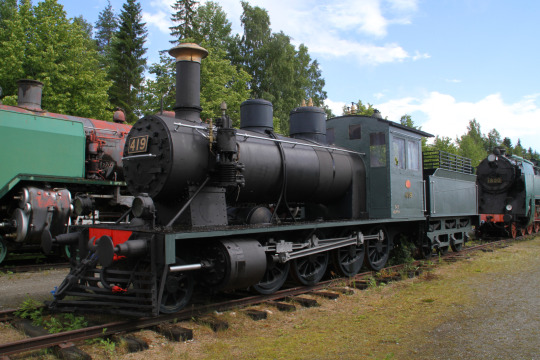
Jos satut olemaan rikas (itse en valitettavasti ole) on nyt tarjolla mahdollisuus ostaa pala suomalaista rautatiehistoriaa: Haapamäen höyryveturipuisto myy Huutokaupat.comissa K2/Tk2-veturia vuodelta 1904. Lähtöhinta on suolainen 30 000 €, mutta tällaista ei kyllä sitten kellään muulla ole mökillään.
Samoin höyryveturipuisto myy neuvostoliittolaista L-veturia (40 000€) sekä matkustajia kuljettavaa puutarharataa Dr12-veturin näköisine vetureineen, vaunuineen ja ratoineen (45 000€).
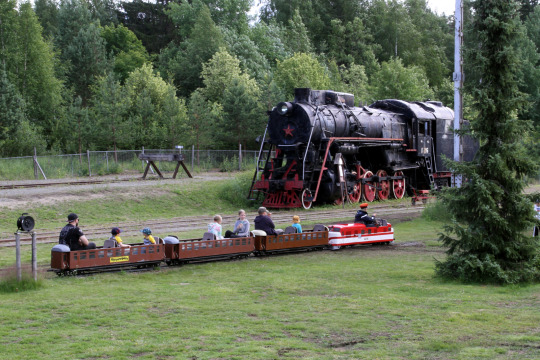
Lisäksi myynnissä on ilmatorjuntatykki, mutta koska VR:n on rauhalle omistautunut yhtiö emme kommentoi sitä enempää. Höyryveturipuiston myynti-ilmoituksen löytyvät täältä: https://huutokaupat.com/haapamaen-hoyryveturipuisto-oy
#suomipaskea#railroad#train#locomotive#haapamäen höyryveturipuisto#soviet union#miten sattuikin että valtionrautatiet-official käytti taas mun valokuvia?#mun kuvat
52 notes
·
View notes